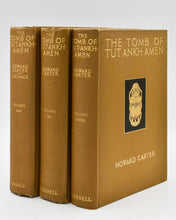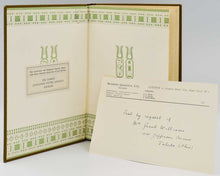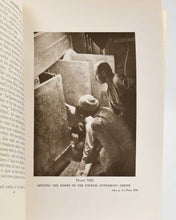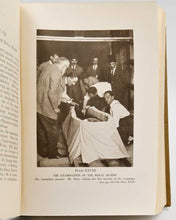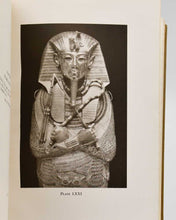
CARTER, Howard, and A.C. MACE [vols II-III by Carter alone]. The Tomb of Tut-Ankh-Amen. London: Cassell. 1923 [-1933].
Three volumes, large 8vo. Original brown cloth, lettered in gilt and with gilt-stamped scarab on black shields on front covers (vol. I with shield in leather, sometimes called presentation issue; the other shields are cloth), “Egyptian” decorated endpapers, printed in light sage green; pp. I: xvi, 231, [1]; II: xxxiv, 277, [1]; III: xvi, 247 [1]; numerous plates after photographs by Harry Burton; front cover of vol. II a little mottled and with short repaired tear to head of spine, only very sporadic minimal spotting to text; a very good set.
First editions, first printings of all three volumes, from the library of the eminent German Egyptologist and lexicographer Adolf Erman (1854-1937).
This legendary three volume set describes one of the most spectacular finds in archaeology, and is a landmark of the discipline and one of the most important books of Egyptology. Howard Carter’s long and varied career in Egyptology began in 1891 when, aged seventeen, he went to Egypt and started working under Flinders Petrie. In 1899, despite having no formal education, Carter was made chief inspector of antiquities in Upper Egypt, partly in recognition of his work on the painted reliefs in the temple of Queen Hatshepsut at Deir al-Bahri in Thebes. However, he lost this position in 1905, due to a disagreement between foreign visitors and the Egyptian antiquities guards.
Prior to the First World War, Carter, financially backed by George Herbert, 5th Earl of Carnarvon, excavated in the Theban necropolis, making important, but unspectacular, discoveries. Carnarvon encouraged Carter to apply for the concession for the Valley of the Kings in 1914. However, the timing was not right and by 1915 Carter was employed by the intelligence department in Cairo, and it was not until 1917 until he was free to return to work for Carnarvon.
Between 1917 and 1922, Carter conducted annual campaigns in the Valley of the Kings. His remarkable discovery took place on 4 November 1922. Starting work earlier than usual, Carter opened up the tomb of Tutankhamun. The tomb was first entered on 26 November, and the discovery astounded the world. On 16 February, the blocking to the burial chamber was removed, to reveal the unplundered body and funerary equipment of the dead king. The excavation work was not completed until 1932. “No archaeological discovery had met with such sustained public interest, yet Carter received no formal honours from his own country” (ODNB).
The set documents in loving detail the most famous archaeological campaign in history and its breathtaking findings.
Provenance: From the library of Adolf Erman, one of the foremost scholars of Ancient Egypt, responsible for placing the study of ancient Egyptian language upon a scientific basis. The set was purchased from Bernard Quaritch Ltd in the 1930s by Caroline Ransom Wiliams (1872-1952), American Egyptologist and pioneering female archaeologist, and one of Erman’s students in Berlin. Through the course of many years, their relationship would blossom from teacher and pupil to close colleagues and friends.
Sets of The Tomb of Tut-Ankh-Amen with important Egyptological provenance have rarely appeared on the market.
#2122067





